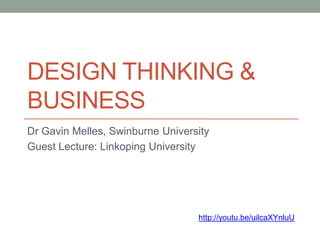
Design thinking & Business
- 1. DESIGN THINKING & BUSINESS Dr Gavin Melles, Swinburne University Guest Lecture: Linkoping University http://youtu.be/uilcaXYnluU
- 3. Design Thinking @ IDEO http://youtu.be/UAinLaT42xY
- 6. Integrative thinking: a third path. • Design thinkers observe the world, imagine alternatives and bring them into being. • Innovations start as intriguing “mysteries.” To unfold them, first develop workable “heuristics” and then derive predictable “algorithms.” • Think of the learning and discovery process as moving through a “knowledge funnel.” • People need analysis and creative thinking at different points in that funnel. • New firms emphasize “exploration.” As they mature, they shift to exploiting known ideas, but if they stop at that point, other innovators will surpass them. • Your organization must balance predictable or “reliable” production with “validity,” experimentation that leads to new ideas and commercial success. • To protect a company, leaders must protect the exploration that leads to its validity. However, over time, organizations tend to emphasize reliability instead. • To develop your design mind, broaden your “personal knowledge system.” • Cultivate the “stance, tools and experiences” that build enhanced “sensitivities and skills.”
- 7. From Mystery to Algorithm • When visionary individuals or corporations derive an algorithm from a heuristic, they create tremendous value. For instance, a new algorithm can eliminate waste by allowing workers to focus on executing precisely the steps they need, and no more. Take McDonald’s. The McDonald brothers successfully addressed a mystery: how to prepare good food the way that people want it. Ray Kroc took their heuristic and pushed it to an algorithm, standardizing portion sizes, cooking times, processes, restaurant design, and so on, for maximum effect. • Power and dangers http://youtu.be/DZqLAJIe7ok
- 8. Example: Proctor & Gamble When A. G. Lafley became CEO of Procter & Gamble (P&G) in June of 2000, it had spent a decade “restructuring” and still hadn’t regained its former glory. Lafley knew P&G needed innovation to bring consumers back, but innovation balanced by efficiency. That made design thinking crucial. Lafley hired Claudia Kotchka for the new position of vice president for design strategy, because he saw design as central to rejuvenating P&G. Kotchka brought in outside experts, including the famed design firm IDEO, to redesign how P&G worked. They added designers to its business teams, retrained the workforce in design thinking and set out to inject design into Procter & Gamble’s DNA. • Kotchka’s Principles of Design Thinking: • Make it user centric through a deep understanding of user habits, need – physical and emotional. • Make it collaborative. Never work alone. There is no one right answer, so it’s not cheating to share information. A mix of skills are essential. (See Ten Faces of Innovation) • Challenge Mental Models. Ask different questions. The problem will look different, requiring a different type of solution. • Abductive. Start with prototype solution and test it. Learn backwards and logic the way to explain the result. • Experimental. Designers prototype with visual and tangible models. It’s easier to discuss something you can see. Prototyping starts the dialogue. It’s not the solutions, but first of a continuous series, if possible solutions. The second version can be radically different. http://www.innovativeye.com/front-end-of-innovation/2006/5/24/claudia-kotchka-design-evangelist-procter-gamble-company.html
- 9. A mindset
- 10. Practical Tools – D.Schooling
- 11. • Brown, T. (2008). Design thinking. Harvard business review, 86(6), 84–92, 141. • Brown, T., & Katz, B. (2009). Change by design: how design thinking transforms organizations and inspires innovation. New York: Harper Collins. • Leavy, B. (2010). Design thinking – a new mental model of value innovation. Strategy & Leadership, 38(3), 5–14. doi:10.1108/10878571011042050 • Martin, R. (2009). The design of business: why design thinking is the next competitive advantage. Boston, MA: Harvard University Press.
